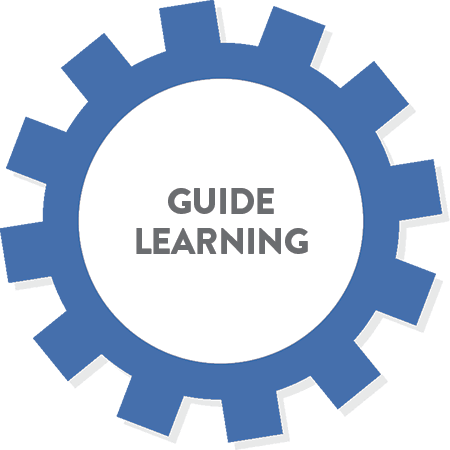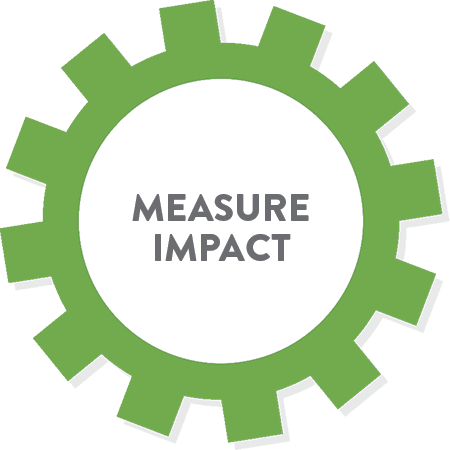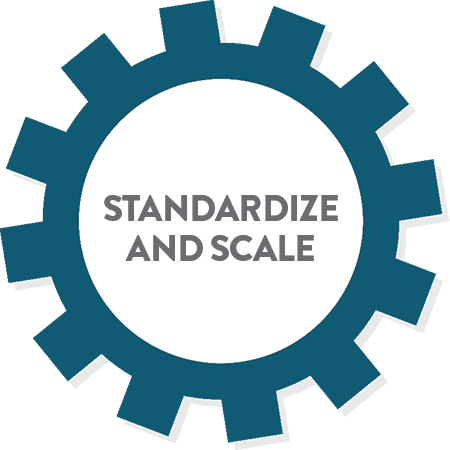How to Make Your Employee Onboarding Program Effective

Improve New Hire Engagement Onboarding,
Productivity, and Retention
Everyone has the same vision of “employee onboarding program paradise.” Your new hires get up to speed quickly. They embrace (and yes, evangelize!) your corporate culture. Above all, these new employees are all set to contribute heavily to the bottom line.
Download How to Make Your Employee Onboarding Program Guide
Sound perfect? It could be. Simple to achieve? That’s something else. The reality is successfully onboarding new hires for long-term happiness and productivity can be extremely challenging. Consider:
- A full third of external hires are no longer with the organization after two years
- Almost a third of employees employed in their current job for fewer than six months are already job searching
- Fewer than a third of executives worldwide are positive about their onboarding experience1
A few days of orientation alone isn’t sufficient to adequately engage new hires and get them off to a fast start. With the war for corporate talent in full swing, it’s time to take a fresh approach. Transform your existing employee onboarding program to strategic onboarding with our employee onboarding best practices.
But how do you get there? The solution: “continual, reinforced learning environments.” (Bersin2) By helping employees learn and apply what they learn on the job, your employee onboarding program will drive the golden benefits of new employee engagement, productivity, and retention.
Employee Onboarding Program Strategy #1:
Extend the Learning Window
Traditional orientation programs are typically transactional in nature. Getting employees set up with technology, training them on basic policies and procedures, and providing functional job overview training are all common activities for orientation.
However, there’s a big difference between this initial set-up and true corporate learning, which is more “relational” than transactional:
Adding the relational component is critical to strategic onboarding. This type of learning is not something that happens in a day, a week, or even a month. It’s something that happens in small chunks, over time.
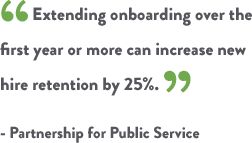
By extending your employee onboarding program past six months to a year or more, your learners will:
1. Learn more completely. Learning in small bites over time, known as the “spacing effect,” enables better understanding, retention, and adoption of workplace learning.
2. Improve performance. Adding on-the-job learning over an extended time period reaps big benefits in terms of helping that employee understand the job, understand how it relates to the organization, and achieve productivity faster.
3. Have higher retention rates. Transforming your organization into a continual learning institution keeps employees engaged and interested, which are key factors for improving new hire retention.
Employee Onboarding Program Strategy #2:
Incorporate Learning Through Others
There’s a lot of value in the “show me, don’t tell me” approach to learning. According to Bersin, people retain only 10 percent of what they read, 50 percent of what they learn through discussion but 75 percent or more from on-the-job experiences. 4
Adding a personalized, 1:1 approach to your extended employee onboarding program greatly improves learning retention since this is how we, as people, naturally want to learn. Some of the benefits you can expect to see through collaborative, in-person learning are:
- Better data retention with the “show” vs. “tell” approach. Hands down, people learn better when shown in person in an on-the-job environment.
- Increased employee engagement. Being face-to-face with someone demands attentive listening and feedback, resulting in a more productive learning experience.
- Ability to understand the “soft” learnings of a job. We all know there’s so much to learn beyond specific job responsibilities to be a success. Understanding intangible aspects like company culture or the weight of departmental priorities can play a huge role in employee satisfaction and, ultimately, success.
- An understanding of the “insider tips” everyone needs to do their job. Who’s your go-to person in accounting to get something approved? What managers should be kept in – or maybe out – of the loop? Understanding these tips is vital to employee performance and success, and it’s not something that’s easily taught in a classroom or online learning environment.
- Reinforcement of knowledge for the “teacher”. Don’t forget – the trainer or new hire buddy providing this knowledge receives benefits too, such as reinforced job skills and a solidified knowledge of company culture, inner workings, and goals.
Pairing people up to learn 1:1 doesn’t need to stop with just one connection. We suggest you provide a network of individual resources to your new hires to provide a wealth of knowledge across the company. With a network, employees will learn more, faster, thereby improving time to productivity. They’ll also feel more connected to the organization, which translates to better integration and retention.
You may want to consider using software to create these individualized learning opportunities. Mentoring software can recommend trainer pairings or new hire buddies to new employees based on business functions, location, job level, and more. You can formalize the pairings as an administrator, or enable your new employees to “shop” for connections.
See how software makes matching new hires easy
Get the eBook Now
Download the Free eBook to Take on the Go
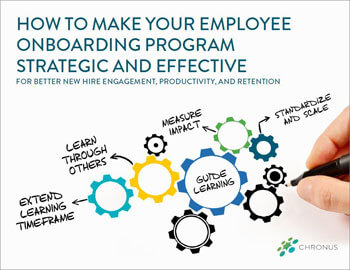
Employee Onboarding Program Strategy #3:
Guide the Learning
Extending the onboarding training process and including individualized on-the-job learning is great. But how can you keep this phase of less formal training focused and productive? In a word: structure.
Just like classroom learning, it’s important to provide a structure for the extended network learning. Often these learning connections start enthusiastically but eventually wane over time. Creating a guided workflow for the entire length of your employee onboarding program ensures that learning is continuous and productive, which speeds your new hire time to productivity.
Providing structure for informal learning can be easy – even a simple checklist will do. Make sure you can customize your structure to include formal classroom training as well as ongoing, 1:1 experiential on-the-job training elements.
Guided employee onboarding plans should provide:
- Specific milestones and tasks. Map out everything from initial classroom training through connecting with a peer through completing new hire learning assignments.
- Helpful on-demand resources. Provide timely training articles or videos to key points in the onboarding process. Software can automate delivery.
- Check-ins and assessments. Build in checkpoints to gauge progress. Self, peer, and managerial assessments can provide new hires with invaluable feedback.
- A definitive end point to the program. Having a clear end point helps employees focus on reaching their goals. It’s also the right time to measure outcomes at the individual, job function, and overall program level.
Onboarding plans should be specific to job functions such as marketing or operations. In high-volume roles like customer service or sales, onboarding plans are often specific to a job title. Over time, you can build a small library of onboarding plans so you can easily deploy them for the next crop of new hires.
See how software can help you create a structured learning plan
Employee Onboarding Program Strategy #4:
Measure the Impact
Chances are, you know your onboarding efforts are successful to some degree. But you may not have specific data. Do you know your typical time to productivity for a new hire? Or whether a specific new employee’s learning was effective? Once you’ve extended your program to include informal learning and connections, how do you measure that? Luckily, it’s all fairly easy to calculate once you focus on tracking these metrics at two levels: the program level and the employee level.
To accurately measure impact, it’s important to set up your metrics at the beginning of the program. At the program level, build metrics around defined business objectives. Some of these can include:
- Before and after new employee attrition rates
- Program completion rates
- Program participation and progression rates
- Group time-to-productivity rates
For individuals, you want to understand the impact your extended onboarding or new hire buddy program specifically has on them. Was the learning productive? Did the employee feel anything was missing? Did they enjoy the process or feel it was a chore? In addition to your standard skills assessment for new employees, another way to aggregate the “softer” data is through participant surveys. We suggest you survey often and make them part of your extended program workflow, so you can spot potential issues that may need correction in your program such as a missing key milestone.
If you’re running an enterprise-scale program, this is an area where software can really help. Use it to track connections, progress of participants, the health of the program, and outcomes. Any good software program will allow you to export your results for easy sharing with program stakeholders.
See how software helps you measure results
Employee Onboarding Program Strategy #5:
Standardize and Scale Your Program for Success
Although it can be tempting to focus on certain key roles when extending your onboarding efforts, the strategic benefits come when the program encompasses all your new hires. Standardizing your onboarding process for repeatability translates to huge benefits for your corporation. According to the Aberdeen Group, organizations with a standardized onboarding process saw:
- 13% higher rates of new hire performance goals met
- 19% higher new hire engagement
- 19% higher new hire retention5

To help you scale your program, consider software. A good program will not only facilitate your informal learning connections, identify your workflow, and provide your key metrics, it will enable you to easily scale your program up and add:
- New groups of participants
- New onboarding program tracks with unique formal and informal workflows
- Additional departments or geographic locations
Only by scaling to your entire organization will you truly realize the large-scale benefits of a strategic onboarding program.
Conclusion
Following this guide, you’ve built your employee onboarding program out to extend past the initial orientation to a longer-term, guided onboarding experience that includes informal learning through others. Hopefully you’ve also planned out the key measurements to demonstrate your program’s success. By carefully building in these steps, it should be fairly easy now to scale your strategic onboarding program across your organization to achieve a uniform, effective new hire experience.
Your new hire buddy program and extended onboarding program will now keep new employees engaged and learning, making their relationship with your organization a positive one. Engaged employees serve as your best corporate evangelists as well as tomorrow’s leadership team, ensuring your upfront investment in new employee onboarding provides an excellent return in terms of productivity, retention, and company growth.
The Role of Software in Employee Onboarding
Running an extended onboarding program that integrates classroom learning with informal, extended on the job training takes effort, resources, and know-how. Software for modern mentoring programs such as buddy programs or extended onboarding, enables you to create a cloud-based program that is easy to use, complete with guided workflows for participants. Plus, for program administrators, software includes an automated toolset to connect and guide participants for productive onboarding. Finally, software provides measurement tools to ensure your program provides effective learning that you can measure to produce return on investment (ROI) metrics for your program.
Mentoring Software Can Help
Watch the video to see how the Chronus mentoring platform makes it easy to start, manage, and measure modern mentorship programs.
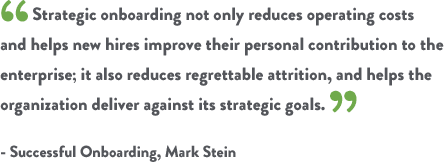

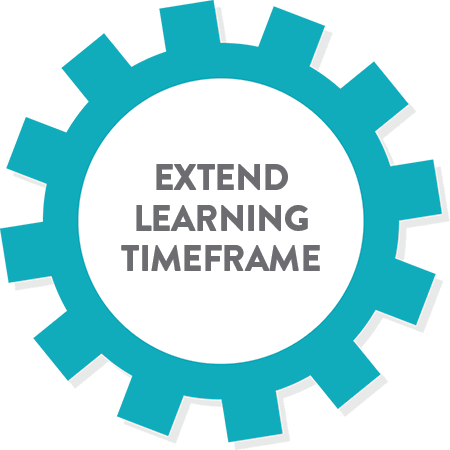

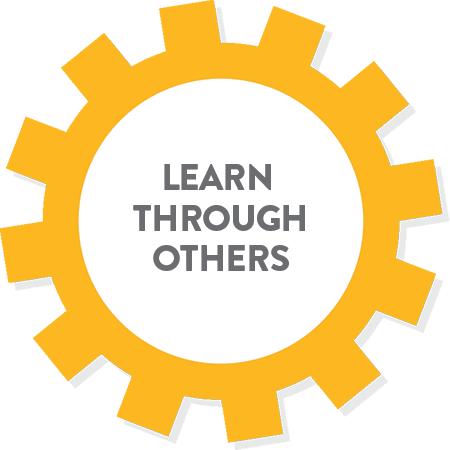
 Pairing people up to learn 1:1 doesn’t need to stop with just one connection. We suggest you provide a network of individual resources to your new hires to provide a wealth of knowledge across the company. With a network, employees will learn more, faster, thereby improving time to productivity. They’ll also feel more connected to the organization, which translates to better integration and retention.
Pairing people up to learn 1:1 doesn’t need to stop with just one connection. We suggest you provide a network of individual resources to your new hires to provide a wealth of knowledge across the company. With a network, employees will learn more, faster, thereby improving time to productivity. They’ll also feel more connected to the organization, which translates to better integration and retention.